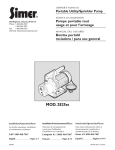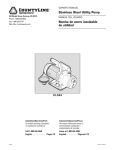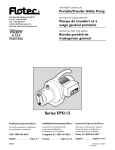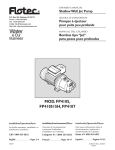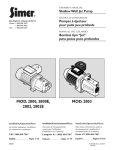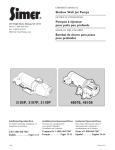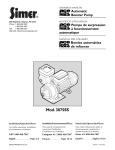Download Simer PORTABLE UTILITY/SPRINKLER PUMP 2825SS Owner`s manual
Transcript
OWNER’S MANUAL Portable Utility/Sprinkler Pump ® 293 Wright St., Delavan, WI 53115 Phone: 1-800-468-7867 1-800-546-7867 Fax: 1-800-390-5351 Model 2825ss Installation/Operation/Parts For further operating, installation, or maintenance assistance: Call 1-800-468-7867 ©2003 PRINTED IN U.S.A. SIM590 (Rev. 5/21/03) Safety 2 READ AND FOLLOW SAFETY INSTRUCTIONS! This is the safety alert symbol. When you see this symbol on your pump or in this manual, look for one of the following signal words and be alert to the potential for personal injury. warns about hazards that will cause serious personal injury, death or major property damage if ignored. warns about hazards that can cause serious personal injury, death or major property damage if ignored. warns about hazards that will or can cause minor personal injury or property damage if ignored. The label NOTICE indicates special instructions which are important but not related to hazards. Carefully read and follow all safety instructions in this manual and on pump. Keep safety labels in good condition. Replace missing or damaged safety labels. GENERAL SAFETY 1. To avoid risk of serious bodily injury and property damage, read the safety instructions carefully before installing this pump. 2. Follow local and/or national plumbing and electrical codes when installing the pump. 3. Hazardous Pressure. The pump body may explode if used as a booster pump unles a relief valve capable of passing the full pump flow at 60 PSI (414 kPa) is installed. Never run the pump dry. To do so can damage internal parts, overheat pump (which can cause burns to people handling or servicing pump), and will void warranty! WARNING Hazardous pressure! Install pressure relief valve in discharge pipe. Release all pressure on system before working on any component. 4. Risk of fire or explosion. To avoid risk of fire and explosion, Pump Water Only with this pump. Do not use this pump in an atmosphere that might contain flammable fumes or vapors. 5. Burn Hazard. If water is trapped in the pump during operation it may turn to steam. Trapped steam can lead to explosion and burns. Never run the pump with the outlet closed or obstructed. 7. If used with a well for potable water, always disinfect the well and test the water for purity before using. Check with your local health department for testing procedures. 8. Complete pump and piping must be protected against freezing. Freezing will cause damage and void the warranty. 9. This pump is not designed, nor intended, for the pumping of chemicals or corrosive liquids. Pump water only with this pump. 10. Do not run pump dry. If the pump is dry, damage will result and void the warranty. ELECTRICAL SAFETY The pump is supplied with a 3-conductor grounding type cord. Connect only to a properly grounded, GFCI protected outlet. Do not lift the pump by the electrical cord. Match the motor voltage and the power supply voltage. The supply voltage must be within +/- 10% of the motor nameplate voltage. Incorrect voltage can cause fire or seriously damage the motor and will void the warranty. If in doubt, consult a licensed electrician. The pump is non-submersible. Keep the motor dry at all times. Do not wash the motor. Do not immerse. Protect the motor from wet weather. If using an extension cord, use only a UL approved indoor/outdoor, 3-wire, grounding type cord. Do not allow any part of the cord or the receptacle ends to sit in water or in damp locations. Unplug the pump before servicing. To avoid fatal shocks, proceed as follows if the pump needs servicing. A. Disconnect the power to the pump outlet box before pulling the pump plug. Modern motors are designed to operate at high temperatures. To avoid burns when servicing pump, allow it to cool Hazardous voltage. Can for 20 minutes after shock, burn, or cause death. shut-down before Ground pump before connecting handling. to power supply. Disconnect B. Take extreme care power before working on pump, when changing fuses. motor or tank. To reduce the chance of fatal electrical shocks, DO NOT stand in water or put your finger in the fuse socket. C. Ground the pressure switch or motor before before running this pump. D. Plug pump into a Ground Fault Circuit Interrupter (GFCI) protected grounded outlet only. WARNING For parts or assistance, call Simer Customer Service at 1-800-468-7867 / 1-800-546-7867 Table of Contents 3 Page General Safety .....................................................................................................2 Warranty ..............................................................................................................3 Installation (Well Pumps) .................................................................................4, 5 Connecting Discharge Piping...............................................................................6 Pressure Booster and Sprinkling ...........................................................................7 Preparing To Start The Pump............................................................................8, 9 Troubleshooting ...................................................................................................9 Repair Parts .......................................................................................................10 Simer Limited Warranty SIMER warrants to the original consumer purchaser (“Purchaser”) of its products that they are free from defects in material or workmanship. If within twelve (12) months from the date of the original consumer purchase any such product shall prove to be defective, it shall be repaired or replaced at SIMER’s option, subject to the terms and conditions set forth below. Your original receipt of purchase is required to determine warranty eligibility. Exceptions to the Twelve (12) Month Warranty Five (5) Year Warranty: If within five (5) years from original consumer purchase any Pre-Charge water system tank shall prove to be defective, it shall be repaired or replaced at SIMER’s option, subject to the terms and conditions set forth below. General Terms and Conditions Purchaser must pay all labor and shipping charges necessary to replace product covered by this warranty. This warranty shall not apply to acts of God, nor shall it apply to products which, in the sole judgement of SIMER, have been subject to negligence, abuse, accident, misapplication, tampering, alteration; nor due to improper installation, operation, maintenance or storage; nor to other than normal application, use or service, including but not limited to, operational failures caused by corrosion, rust or other foreign materials in the system, or operation at pressures in excess of recommended maximums. Requests for service under this warranty shall be made by returning the defective product to the Retail outlet or to SIMER as soon as possible after the discovery of any alleged defect. SIMER will subsequently take corrective action as promptly as reasonably possible. No requests for service under this warranty will be accepted if received more than 30 days after the term of the warranty. This warranty sets forth SIMER’s sole obligation and purchaser’s exclusive remedy for defective products. SIMER SHALL NOT BE LIABLE FOR ANY CONSEQUENTIAL, INCIDENTAL, OR CONTINGENT DAMAGES WHATSOEVER. THE FOREGOING WARRANTIES ARE EXCLUSIVE AND IN LIEU OF ALL OTHER EXPRESS WARRANTIES. IMPLIED WARRANTIES, INCLUDING BUT NOT LIMITED TO THE IMPLIED WARRANTIES OF MERCHANTABILITY AND FITNESS FOR A PARTICULAR PURPOSE, SHALL NOT EXTEND BEYOND THE DURATION OF THE APPLICABLE EXPRESS WARRANTIES PROVIDED HEREIN. Some states do not allow the exclusion or limitation of incidental or consequential damages or limitations on how long an implied warranty lasts, so the above limitations or exclusions may not apply to you. This warranty gives you specific legal rights and you may also have other rights which vary from state to state. SIMER • 293 Wright St. • Delavan, WI U.S.A. 53115 Phone: 1-800-468-7867 / 1-800-546-7867 • Fax: 1-800-390-5351 For parts or assistance, call Simer Customer Service at 1-800-468-7867 / 1-800-546-7867 Installation 4 SPECIFICATIONS Power Supply Required. ...................................115 Volts Motor Duty ...................................................Continuous Circuit Requirement (minimum) .....................15.0 Amps Discharge Adapter .......................................................1” SHALLOW WELL JET PUMP INSTALLATIONS: • Have a vertical depth of 25’ or less. • Have one pipe from the well to the pump case. • Can be installed in a bored or drilled well, or in a driven well. REPLACING AN OLD PUMP Hazardous voltage. Can shock, burn or kill. Disconnect power to pump before working on pump or motor. 1. Drain and remove the old pump. Check the old pipe for scale, lime, rust, etc., and replace it if necessary. To Household Water System Pump Priming Tee and Plug Suction Pipe From Well Priming Tee and Plug Check Valve Drive Coupling 2. Install the pump in the system. Make sure that all pipe joints in the suction pipe are air-tight as well as water tight. If the suction pipe can suck air, the pump will not be able to pull water from the well. 3. Adjust the pump mounting height so that the plumbing connections do not put a strain on the pump body. Support the pipe so that the pump body does not take the weight of piping or fittings. You have just completed the well plumbing for your new shallow well jet pump. Please go to Page 6 for discharge pipe and tank connections. WELL POINT (DRIVEN POINT) INSTALLATION (FIGURE 1) 1. Drive the well, using “drive couplings” and a “drive cap”. “Drive fittings” are threaded all the way through and allow the pipe ends to butt against each other so that the driving force of the maul is carried by the pipe and not by the threads. The ordinary fittings found in hardware stores are not threaded all the way through the fitting and can collapse under impact. “Drive fittings” are also smoother than standard plumbing fittings, making ground penetration easier. 2. Mount the pump as close to the well as possible 3. Use the fewest possible fittings (especially elbows) when connecting the pipe from the well point to the pump suction port. The suction pipe should be at least as large as the suction port on the pump (include a check valve if your pump is not equipped with one – see Figure 1). Support the pipe so that there are no dips or sags in the pipe, so it doesn’t strain the pump body, and so that it slopes slightly upward from the well to the pump (high spots can cause air pockets which can air lock the pump). Seal the suction pipe joints with teflon tape. Joints must be air and water tight. If the suction pipe can suck air, the pump cannot pull water from the well. If one well point does not supply enough water, consider connecting two or three well points to one suction pipe. You have just completed the suction piping for your new shallow well jet pump. Please go to Page 6 for discharge pipe and tank connections. Drive Point Not to Scale 3938 0401 Figure 1 – Driven Point Installation PERFORMANCE Model 2825ss 0 10 10 8.5 20 8.0 Output Pressure 30 7.5 40 7.0 For parts or assistance, call Simer Customer Service at 1-800-468-7867 50 6.0 / 1-800-546-7867 Maximum PSI 80 Installation 5 CASED WELL INSTALLATION, 2” OR LARGER CASING (FIGURE 2) INSTALLATION FOR SURFACE WATER (FIGURE 3) 1. Mount the pump as close to the well as possible. 2. Assemble the foot valve, strainer, and well pipe (see Figure 2). Make sure that the foot valve works freely. 3. Lower the pipe into the well until the strainer is five feet above the bottom of the well. It should also be at least 10 feet below the well’s water level while the pump is running in order to prevent the pump from sucking air. Install a sanitary well seal. 4. Install a priming tee, priming plug, and suction pipe to the pump (see Figure 2). Connect the pipe from the well to the pump suction port, using the fewest possible fittings – especially elbows – as fittings increase friction in the pipe (however, include a foot valve – see Figure 2). The suction pipe should be at least as large as the suction port on the pump. Use teflon tape or a teflon-based pipe joint compound on threaded pipe joints. Support the pipe so that there are no dips or sags in the pipe, so it doesn’t strain the pump body, and so that it slopes slightly upward from the well to the pump (high spots can cause air pockets which can air lock the pump). Seal the suction pipe joints with teflon tape. Joints must be air and water tight. If the suction pipe can suck air, the pump cannot pull water from the well. You have just completed the suction piping for your new shallow well jet pump. Please go to Page 6 for discharge pipe and tank connections. 1. The pump should be installed as close to the water as possible, with the fewest possible fittings (especially elbows) in the suction pipe. The suction pipe should be at least as large as the suction port on the pump. 2. Assemble a foot valve and suction pipe (see Figure 3). Make sure that the foot valve works freely. Use teflon tape or a teflon-based pipe joint compound on threaded pipe joints. Protect the foot valve assembly from fish, trash, etc, by installing a screen around it (see Figure 3). 3. Lower the pipe into the water until the strainer is five feet above the bottom. It should also be at least 10 feet below the water level in order to prevent the pump from sucking air. 4. Install a priming tee, priming plug, and suction pipe to the pump (see Figure 3). Support the pipe so that there are no dips or sags in the pipe, so it doesn’t strain the pump body, and so that it slopes slightly upward from the well to the pump (high spots can cause air pockets which can air lock the pump). Seal the suction pipe joints with teflon tape. Joints must be air and water tight. If the suction pipe can suck air, the pump cannot pull water from the well. You have just completed the plumbing for your new shallow well jet pump. Please go to Page 6 for discharge pipe and tank connections. To Household Water System To Household Water System Pump Priming Tee and Plug Pump Priming Tee and Plug Check Valve Suction Pipe From Well Check Valve Suction Pipe From Well Priming Tee and Plug Priming Tee and Plug Sanitary Well Seal Well Casing Foot Valve 10' Min. Foot Valve 5–10' Not to Scale Screen 3941 0401 Figure 2 – Cased Well Installation Figure 3 - Surface Water Installation For parts or assistance, call Simer Customer Service at 1-800-468-7867 / 1-800-546-7867 10' Min. 5' Discharge Pipe and Pressure Tank Connections 6 PRE-CHARGE TANK CONNECTION (FIGURE 4) STANDARD TANK CONNECTION (FIGURE 5) 1. Install two tees in the pump discharge port (see Figure 4). The pipe size must be at least as large as the discharge port. 2. Run a pipe or reinforced hose from one arm of the first tee to the port on the pre-charged tank. 3. Connect the other end of the discharge tee to your plumbing system. 4. Check the pre-charge of air in the tank with an ordinary tire gauge. The pre-charge should be 2 PSI less than the cut-in setting of the pump’s pressure switch. The pre-charge is measured when there is no water pressure in the tank. Your new pump has a 30/50 PSI switch, so adjust the tank pre-charge pressure to 28 PSI. Congratulations! You have just completed the tank connection for your jet pump. 1. Install one tee in the pump discharge port (see Figure 5). 2. Run a pipe from the pump discharge port to the inlet port of your tank. The pipe size must be at least as large as the discharge port. 3. Remove the 1/8” NPT pipe plug from the pump Air Volume Control (AVC) port (see Figure 5). Run tubing from the pump’s AVC port (see Figure 5) to the port on the AVC mounted on the tank. See instructions provided with tank and AVC for details. AVC port location will vary, depending on your pump model (see exploded views, Page 10). To Household Water System To Household Water System Pump Priming Tee and Plug Pressure Switch Check Valve Pump Priming Tee and Plug Pressure Switch Air Volume Control Air Volume Control Tube Suction Pipe From Well Pump AVC Port From Well Not to Scale Figure 5 – Standard Tank Connections Sealing Pipe Joints Not to Scale Figure 4 – Pre-charged Tank Connections Use only Teflon tape for making all threaded connections to the pump itself. Do not use pipe joint compounds on plastic pumps: they can react with the plastic in pump components. Make sure that all pipe joints in the suction pipe are air tight as well as water tight. If the suction pipe can suck air, the pump will not be able to pull water from the well. For parts or assistance, call Simer Customer Service at 1-800-468-7867 / 1-800-546-7867 Pressure Boosting and Sprinkling 7 BOOSTING CITY WATER PRESSURE Hazardous pressure. Never run the pump against a closed discharge. To do so can boil the water inside the pump, causing hazardous pressure in the pump causing the risk of explosion and possibly scalding persons nearby. See Figure 6. Connect the Pump Inlet to the Water Faucet for use with Sprinklers. Water Faucet Hose Adapters 3942 0401 Figure 8 – Connect pump to a spigot for use with sprinklers. Connect with adapters supplied with pump 1117 0993 Figure 6: Do Not Run Pump With Outlet Shut Off When using the pump as a high-pressure washer, use only a reinforced high pressure hose or pipe for the discharge line. When using a garden hose, install adapters to the pump suction and the discharge. The suction hose will require two female ends. Either use a standard washing machine supply hose or modify a short piece of standard 1” garden hose as a suction line (See Figure 7). PIPING Both the suction and discharge ports are tapped for 1" BSP threads. If using hoses, use hose adapters. See Figure 7. Do not use a hose on the suction if pumping from lakes, streams or ponds. The hose will collapse and cause pump failure. Install a strainer with a foot valve on the end of the suction line. Inspect and clean the strainer frequently (Figure 9). NOTICE: An air leak in the suction pipe may draw air in although no water leaks out. Make sure there are no air leaks or air pockets in the suction pipe. 115V, GFCI Protected, Grounded Outlet Box Discharge Line (Garden Hose or Rigid Pipe) Hose Adapters Hose Adapters Suction Line (Garden Hose or Rigid Pipe) Figure - 7 Hose adapter installation Footvalve with strainer (clean frequently) Hazardous pressure. Do not shut off the hose or the sprinklers while the pump is running. The hose or sprinkler head may explode. Figure - 9 Strainer and footvalve installaton For parts or assistance, call Simer Customer Service at 1-800-468-7867 / 1-800-546-7867 Preparing To Start The Pump PRIMING/OPERATION NOTICE: Do not run the pump dry. Running the pump without water can damage the impeller and may damage the seal, causing leaking or flooding, and will void warranty. All suction connections must be airtight. Make sure the suction lift is not more than 25 feet (7.6M). Fill the pump body through the priming port before starting the pump. Start the pump; it should pump water in under 10 minutes (depending on the length of the suction hose and the height of the pump above water). PREPARING TO START THE PUMP (REFER TO FIGURE 10) Risk of burns. Never run pump dry. Running the pump without water may cause the pump to overheat, damaging the seal and possibly causing burns to persons handling the pump. Fill the pump with water before starting. Hazardous Pressure. Never run the pump against closed discharge. To do so can boil water inside pump, causing hazardous pressure in unit, risk of explosion and possibly scalding persons handling pump. 1. Remove the priming plug from the priming tee and fill the pump. Fill all piping between the pump and the well and make sure that all piping in the well is full. If you have also installed a priming tee in the suction piping, remove the plug from the tee and fill the suction piping. See Figure 10. 2. Replace all fill plugs. 3. Power on! Start the pump. If you don’t have water after 2 or 3 minutes, stop the pump and remove the fill plugs. Refill the pump and piping. You may have 8 to repeat this several times in order to get all of the trapped air out of the piping. A pump lifting water 25’ may take as long as 15 minutes to prime. 4. After the pump has built up pressure in the system and shut off, check the pressure switch operation by opening a faucet or two and running enough water out to bleed off pressure until the pump starts. The pump should start when the pressure drops to 30 PSI and stop when the pressure reaches 50 PSI. Run the pump through one or two complete cycles to verify correct operation. This will also help clean the system of dirt and scale dislodged during installation. Congratulations on a successful installation. If you were unsuccessful, please refer to the Troubleshooting section (Page 9) or call our customer service technical staff at 1-800-468-7867. Remove the plug and fill the pump and the piping through the priming tee. Figure 10: Prime the Pump For parts or assistance, call Simer Customer Service at 1-800-468-7867 / 1-800-546-7867 Troubleshooting SYMPTOM 9 POSSIBLE CAUSE(S) CORRECTIVE ACTION Motor will not run Fuse is blown or circuit breaker tripped DISCONNECT POWER;Replace fuse or reset circuit breaker. Motor runs hot and the overload kicks off or the does not run and only hums. Voltage is too low Check voltage being supplied to the pump. Motor runs but no water is delivered* Pump during new installation did not pick up prime through: 1. Improper priming 2. Air leaks In new installation: * (Note: Stop pump; then check prime before looking for other causes. Unscrew priming plug and see if water is in priming hole). *Pump does not (7.6M) deliver water to full capacity Impeller is plugged Foot valve is stuck shut Pipes are frozen Foot valve and/or strainer are buried in sand or mud 1. Re-prime according to instructions. 2. Check all connections on suction line, with soapy water or shaving cream. 3. Replace foot valve. 4. Re-pipe using size of suction and discharge ports on pump. In installation already in use: 1. Check all connections on suction line and shaft seal with soapy water. 2. Lower suction line into water and re-prime. If receding water level in well exceeds 25’ (7.6M), a deep well pump is needed. Clean impeller. Replace the foot valve. Thaw pipes. Raise the foot valve and/or strainer above bottom of water source. Clean foot valve and strainer. Water beign pumped is lower than A deep well jet will may needed if the water being pumped is more than 25’ estimated Steel piping (if used) is corroded or limed, causing excess friction Piping is too small in size Pump not being supplied with enough water depth to water. Replace with plastic pipe where possible, otherwise with new steel pipe. 3. Leaking foot valve. 4. Pipe size is too small Pump has lost prime through: 1. Air leaks 2. Water level below suction pipe inlet Re-pipe using size of suction and discharge ports on pump. Add additional well points. For parts or assistance, call Simer Customer Service at 1-800-468-7867 / 1-800-546-7867 Repair Parts 10 8 7 6 18 5 4 2 17 3 1 16 13 11 29 12 10 9 14 2 3 15 19 20 21 22 23 24 22 25 26 27 3985 0501 28 Key No. 1 2 3 4 5 6 7 8 9 10 11 12 13 14 15 16 17 18 19 20 21 22 23 24 25 26 27 28 29 Part Description Pump Body O-Ring, Drain Plug Drain Plug O-Ring, Nozzle Diffuser, Venturi, Nozzle Assembly Impeller Mechanical Seal, Assembly O-Ring, Pump Body Flange Intermediate Support Handle Washer, Handle Screw, Handle Lock Nut, Handle Water Singer Handle Grip, Handle Fan,Cooling Fan Cover Power Cord Screws, Capacitor Holder Grounding Lug Capacitor Box W/ Cover Capacitor O-Ring, Capacitor Box Washer, Ground Screw Lockwasher, Ground Screw Screw, Ground Base Assembly Screw, Pump Body No. Used Part Number 1 2 2 1 1 1 1 1 1 1 1 1 1 1 1 1 1 1 1 11 1 1 1 1 1 1 1 1 6 723S2290 111P0990 121P2100 111P0480 101P2840 731S2220 ZBR00010 111P1190 101P1290 731P0170 101P1450 121P1500 121P1600 121P0950 102P0540 102P1650 102P0570 721S1090 191P0560 121P2060 171P4070 102P2830 171P5430 111P1350 121P0090 121P0920 121P1280 ZBR05420 121P0340 For parts or assistance, call Simer Customer Service at 1-800-468-7867 / 1-800-546-7867 11 For parts or assistance, call Simer Customer Service at 1-800-468-7867 / 1-800-546-7867 12 For parts or assistance, call Simer Customer Service at 1-800-468-7867 / 1-800-546-7867












